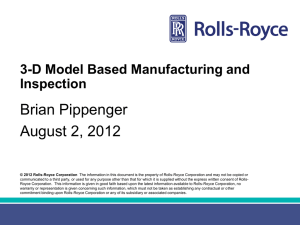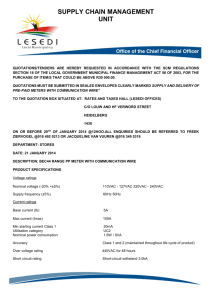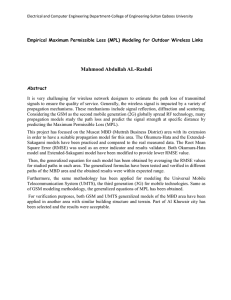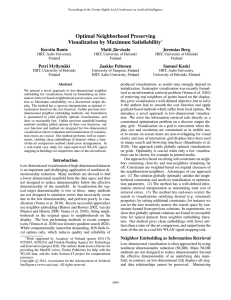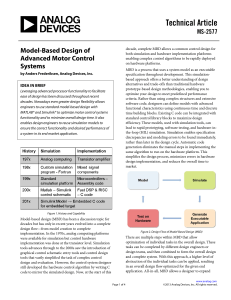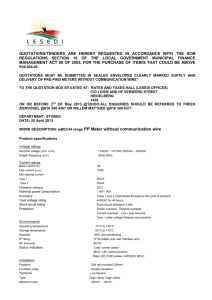Efficient Model Based Diagnosis with Maximum Satisfiability
advertisement
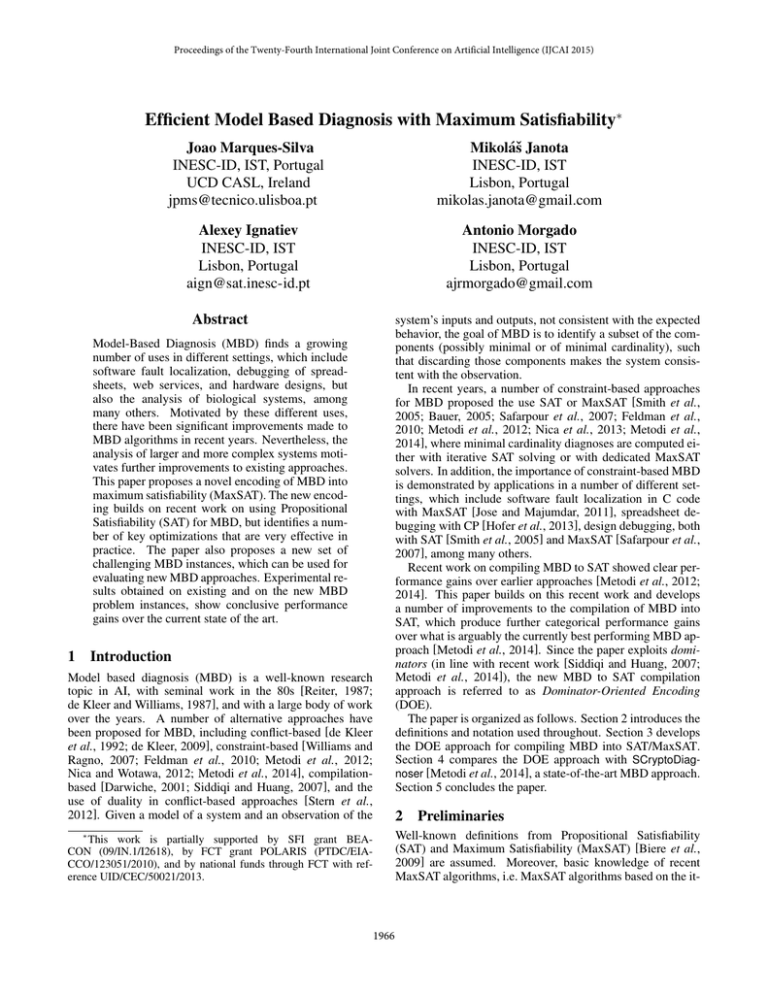
Proceedings of the Twenty-Fourth International Joint Conference on Artificial Intelligence (IJCAI 2015)
Efficient Model Based Diagnosis with Maximum Satisfiability∗
Joao Marques-Silva
INESC-ID, IST, Portugal
UCD CASL, Ireland
jpms@tecnico.ulisboa.pt
Mikoláš Janota
INESC-ID, IST
Lisbon, Portugal
mikolas.janota@gmail.com
Alexey Ignatiev
INESC-ID, IST
Lisbon, Portugal
aign@sat.inesc-id.pt
Antonio Morgado
INESC-ID, IST
Lisbon, Portugal
ajrmorgado@gmail.com
system’s inputs and outputs, not consistent with the expected
behavior, the goal of MBD is to identify a subset of the components (possibly minimal or of minimal cardinality), such
that discarding those components makes the system consistent with the observation.
In recent years, a number of constraint-based approaches
for MBD proposed the use SAT or MaxSAT [Smith et al.,
2005; Bauer, 2005; Safarpour et al., 2007; Feldman et al.,
2010; Metodi et al., 2012; Nica et al., 2013; Metodi et al.,
2014], where minimal cardinality diagnoses are computed either with iterative SAT solving or with dedicated MaxSAT
solvers. In addition, the importance of constraint-based MBD
is demonstrated by applications in a number of different settings, which include software fault localization in C code
with MaxSAT [Jose and Majumdar, 2011], spreadsheet debugging with CP [Hofer et al., 2013], design debugging, both
with SAT [Smith et al., 2005] and MaxSAT [Safarpour et al.,
2007], among many others.
Recent work on compiling MBD to SAT showed clear performance gains over earlier approaches [Metodi et al., 2012;
2014]. This paper builds on this recent work and develops
a number of improvements to the compilation of MBD into
SAT, which produce further categorical performance gains
over what is arguably the currently best performing MBD approach [Metodi et al., 2014]. Since the paper exploits dominators (in line with recent work [Siddiqi and Huang, 2007;
Metodi et al., 2014]), the new MBD to SAT compilation
approach is referred to as Dominator-Oriented Encoding
(DOE).
The paper is organized as follows. Section 2 introduces the
definitions and notation used throughout. Section 3 develops
the DOE approach for compiling MBD into SAT/MaxSAT.
Section 4 compares the DOE approach with SCryptoDiagnoser [Metodi et al., 2014], a state-of-the-art MBD approach.
Section 5 concludes the paper.
Abstract
Model-Based Diagnosis (MBD) finds a growing
number of uses in different settings, which include
software fault localization, debugging of spreadsheets, web services, and hardware designs, but
also the analysis of biological systems, among
many others. Motivated by these different uses,
there have been significant improvements made to
MBD algorithms in recent years. Nevertheless, the
analysis of larger and more complex systems motivates further improvements to existing approaches.
This paper proposes a novel encoding of MBD into
maximum satisfiability (MaxSAT). The new encoding builds on recent work on using Propositional
Satisfiability (SAT) for MBD, but identifies a number of key optimizations that are very effective in
practice. The paper also proposes a new set of
challenging MBD instances, which can be used for
evaluating new MBD approaches. Experimental results obtained on existing and on the new MBD
problem instances, show conclusive performance
gains over the current state of the art.
1
Introduction
Model based diagnosis (MBD) is a well-known research
topic in AI, with seminal work in the 80s [Reiter, 1987;
de Kleer and Williams, 1987], and with a large body of work
over the years. A number of alternative approaches have
been proposed for MBD, including conflict-based [de Kleer
et al., 1992; de Kleer, 2009], constraint-based [Williams and
Ragno, 2007; Feldman et al., 2010; Metodi et al., 2012;
Nica and Wotawa, 2012; Metodi et al., 2014], compilationbased [Darwiche, 2001; Siddiqi and Huang, 2007], and the
use of duality in conflict-based approaches [Stern et al.,
2012]. Given a model of a system and an observation of the
2
Preliminaries
Well-known definitions from Propositional Satisfiability
(SAT) and Maximum Satisfiability (MaxSAT) [Biere et al.,
2009] are assumed. Moreover, basic knowledge of recent
MaxSAT algorithms, i.e. MaxSAT algorithms based on the it-
∗
This work is partially supported by SFI grant BEACON (09/IN.1/I2618), by FCT grant POLARIS (PTDC/EIACCO/123051/2010), and by national funds through FCT with reference UID/CEC/50021/2013.
1966
erative identification of unsatisfiable subformulas (or cores),
is also assumed [Ansótegui et al., 2013; Morgado et al.,
2013]. In addition, standard definitions of circuits are assumed [Biere et al., 2009], including controlling (resp. noncontrolling) input values of simple gates, concretely 0 (resp.
1) for AND/NAND and 1 (resp. 0) for OR/NOR).
The paper assumes standard model-based diagnosis
(MBD) definitions, following Reiter’s seminal work [Reiter,
1987] and used in most modern references [Reiter, 1987;
Siddiqi, 2011; Metodi et al., 2012; Nica et al., 2013; Metodi
et al., 2012]. As in recent work, the weak fault model (WFM)
is assumed throughout. A system description SD is a set of
first-order sentences [Reiter, 1987]. The system components,
Comps, are a set of constants, Comps = {c1 , . . . , cm }. Given
a system description SD, composed of a set of components
Comps, each component can be declared as healthy or unhealthy. For each component c ∈ Comps, Ab(c) = 1 if c is
declared as unhealthy; otherwise Ab(c) = 0. Similarly to earlier work [Feldman et al., 2010; Metodi et al., 2012], it is
assumed that SD is represented as a CNF formula, namely:
SD ,
^
1
2
3
4
5
6
7
8
Algorithm 1: MBD to MaxSAT compilation
Figure 1 summarizes the most often used SAT-based approach for MBD [Smith et al., 2005; Feldman et al., 2010;
Nica et al., 2013]. Recent work on SAT-based MBD [Metodi
et al., 2012; 2014] develops a more sophisticated model, by
using logical equivalence between the unhealthy variable of
a component and its associated CNF encoding, and also by
exploiting structural properties of the system description, including graph dominators and sections.
3
(1)
(Ab(c) ∨ Fc )
c∈Comps
Definition 1 (Diagnosis Problem) A system with description SD is faulty if its model is inconsistent with a given observation Obs when all components are declared healthy, i.e.:
^
(2)
¬Ab(c) ⊥
c∈Comps
The problem of diagnosis is to identify a set of components
which, if declared unhealthy, make the system consistent with
the observation. The problem of MBD is represented by the
3-tuple hSD, Comps, Obsi.
Definition 2 (Diagnosis) Given
an
MBD
3.1
problem
a diagnosis if
^
c∈∆
Ab(c) ∧
^
¬Ab(c) 2 ⊥
Dominators, TLDs & Hard Components
A well-known technique to constrain the CNF encoding is to
consider the immediate dominators of the circuit graph [Siddiqi and Huang, 2007; Metodi et al., 2012].
Let O denote a special vertex to which every circuit output
is connected. Vertex v is a dominator of vertex u if all paths
from u to O include v [Lengauer and Tarjan, 1979]. Vertex
v is an immediate dominator of u if every other dominator of
u is also a dominator of v . A circuit gate is dominated if its
immediate dominator is not O; otherwise it is non-dominated.
If a dominated gate is included in some minimalcardinality diagnosis, then it can be replaced by its immediate
(non-dominated) dominator gate [Siddiqi and Huang, 2007].
Thus, one can analyze solely the minimal cardinality diagnoses that do not involve dominated gates. These are referred
to as top-level diagnoses (TLDs) [Siddiqi and Huang, 2007;
Metodi et al., 2012; 2014].
Definition 3 (Top-Level Diagnosis (TLD)) A minimal cardinality diagnosis is a top-level diagnosis if it does not contain dominated gates.
hSD, Comps, Obsi, the set of components ∆ ⊆ Comps is
SD ∧ Obs ∧
Efficient MBD with MaxSAT
The novel approach for compiling MBD into MaxSAT is
summarized in Algorithm 1. Lines 2 to 7 preprocess the
system as described in the following sections. The objective
is to generate a simpler MaxSAT instance than what would be
achieved with the basic MaxSAT encoding (described in Section 2). The main loop is executed while additional changes
are identified. Line 6 bounds the maximum number of iterations of the algorithm, so that the (quasi-quadratic) worst case
running time is not observed. Line 8 generates the MaxSAT
formula, using the basic encoding described above, but also
taking into account the information generated by the preprocessing phase. The MBD to MaxSAT encoding proposed
in this paper referred to as Dominator-Oriented Encoding
(DOE), given the way dominators are exploited in the compilation process. The rest of this section details each preprocessing step.
where Fc denotes the CNF encoding of component c.
Observations are used to represent situations where the behavior of the system is not the expected one. An observation
Obs is defined as a finite set of first-order sentences [Reiter,
1987]. As with the system description, it is assumed that the
observation can be encoded into CNF, as a set of unit clauses,
and denoted Obs.
SD ∧ Obs ∧
global: hSD, Comps, Obsi
repeat
FindDominators()
FindBackboneComponents()
FindBlockedConnections()
if MaxNumberIterations() then break
until NoMoreChanges()
GenMaxsatModel()
(3)
c∈Comps\∆
A diagnosis ∆ is minimal if no proper subset ∆0 ( ∆ is a
diagnosis, and ∆ is of minimal cardinality if there exists no
other diagnosis ∆0 ⊆ Comps with |∆0 | < |∆|.
To model MBD with MaxSAT [Safarpour et al., 2007;
Feldman et al., 2010], SD (see (1)) represents the hard
clauses, whereas the soft clauses are unit clauses (¬Ab(c)),
one for each component c ∈ Comps. This is referred to as
the basic MaxSAT encoding in this paper. Different MaxSAT
solving approaches can then be applied. Alternatively, the
soft clauses can be replaced by a cardinality constraint and
solved iteratively with a SAT solver.
1967
i1
z1
i2
o1
z3
i3
i4
i5
z2
o2
z4
(a) C17 circuit
Obs
hi1 , i2 , i3 , i4 , i5 i
ho1 , o2 i
19
h1, 0, 0, 0, 1i
h1, 1i
20
h0, 1, 1, 1, 1i
h1, 1i
51
h1, 0, 1, 1, 1i
h0, 1i
53
h1, 1, 1, 0, 1i
h0, 0i
63
h1, 0, 1, 0, 1i
h0, 0i
(b) Selected observations
Comps
SD
Fz1
Fz2
Fz3
Fz4
Fo1
Fo2
,
,
,
,
,
,
,
,
{z1 , z2 , z3 , z4 , o1 , o2 }
V
c∈Comps (Ab(c) ∨ Fc )
CNF(z1 ↔ ¬(i1 ∧ i3 ))
CNF(z2 ↔ ¬(i3 ∧ i4 ))
CNF(z3 ↔ ¬(i2 ∧ z2 ))
CNF(z4 ↔ ¬(z2 ∧ i5 ))
CNF(o1 ↔ ¬(z1 ∧ z3 ))
CNF(o2 ↔ ¬(z3 ∧ z4 ))
(c) MBD formulation
Figure 1: C17 circuit and selected observations from ISCAS85 scenarios
Recent work [Siddiqi and Huang, 2007; Siddiqi, 2011;
Metodi et al., 2012; 2014] focuses on computing TLDs. The
other minimal cardinality diagnoses can be enumerated by
iteratively replacing a non-dominated gate by a dominated
gate, and then checking for consistency. This is in practice
simpler than solving MaxSAT, since one call to a SAT solver
on a simpler formula suffices. This approach is also assumed
in this paper.
In the DOE MaxSAT problem formulation, immediate
dominators are computed with a standard (quasi-)linear time
algorithm [Lengauer and Tarjan, 1979]. In terms of the problem encoding, since dominated gates are not included in
TLDs, these can be encoded as hard clauses, and referred to
as hard components. Thus, unhealthy variables Ab(c) are only
associated with non-dominated components, each of which is
associated with a soft clause.
backbone literals [Janota et al., 2015], in the DOE approach
for MBD, backbone nodes are identified by value propagation through dominated components. In addition, the fact that
dominated components can be declared backbone nodes allows the identification of connections that cannot be used for
computing TLDs.
Definition 5 (Blocked Edge (B-Edge)) A fanin edge e of a
component g is blocked if the output value of g remains unchanged for any value assigned to the fanin edge e.
Proposition 2 For any computed TLD, if a fanin node of a
component g is a B-Node and it is assigned the controlling
value of g , then the other unassigned fanin edges of g are
B-Edges.
Example 2 For the example in Figure 1, z1 is dominated. If
i1 = i3 = 1, then z1 = 0. In this case, edge (z3 , o1 ) is a Bedge. This information can lead to further simplifications, as
illustrated below.
Proposition 1 For any computed TLDs, dominated gates are
declared healthy.
Remark 1 For computing TLDs (and minimal cardinality diagnoses), dominated gates are modeled as hard clauses.
3.3
Blocked edges can now be used for determining nodes and
edges which need not be added to the generated CNF formula.
Remark 1 serves to simplify the MaxSAT problem instance,
by reducing the number of soft clauses, since hard components cannot be declared unhealthy when computing TLDs.
3.2
Filtered Nodes and Edges
Definition 6 (Filtered Edge) An edge is filtered if it is
blocked or if its fanout node is filtered.
Backbone Nodes & Blocked Edges
Definition 7 (Filtered Node) A node is filtered if all of its
fanout edges are filtered.
In practice, Remark 1 results in significant reduction in the
number of used unhealthy variables if the number of dominated components is also significant1 . More importantly, if
the output value of a dominated component can be determined given its input values then, because the component
cannot be declared unhealthy, the output value of the component can be encoded as a hard unit clause.
Remark 2 As the result of the preprocessing step of DOE
compilation, filtered edges and nodes are not encoded into
CNF.
Let F denote the basic CNF encoding of the system (described in Section 2), consisting of CNF encoding the system
and associated observation, respectively SD and Obs. Moreover, let F f denote the CNF encoding of the system where
filtered nodes are not encoded into CNF, respectively SDf and
Obsf . Finally, let ∆ be a computed minimal cardinality diagnosis using F .
Definition 4 (Backbone Node (B-Node)) A
dominated
component for which the output value is fixed for any TLD is
a backbone node (B-Node).
Example 1 For the example in Figure 1, z1 is always dominated. Thus, if i1 = i3 = 1, then z1 = 0 for any TLD. In
contrast, if i1 = 0 (or i3 = 0), then z1 = 1 for any TLD.
Proposition 3 ∆ is a TLD for SD given Obs iff ∆ is a TLD
for SDf given Obsf .
The definition of backbone node mimics that of backbone literal [Monasson et al., 1999; Slaney and Walsh, 2001]. Although there are recent practical algorithms for computing
Another important consequence of identifying filtered
edges and nodes is that this enables detecting additional dominated components, which can lead to finding additional BNodes, B-Edges, and so additional filtered nodes and edges.
As shown in Algorithm 1, this process is repeated while
1
Observe that components represent circuit gates. Moreover,
each component can be viewed as a node in a directed graph.
1968
Obs
Dominated
B-Nodes
B-Edges
Soft
CSs
|X|
|H|
|S|
19
20
51
53
63
{z1 , z4 , z2 }
{z1 , z4 }
{z1 , z4 , z2 , z3 }
{z1 , z4 , z3 }
{z1 , z4 , z2 , z3 }
{z1 }
{z1 }
{z̄1 , z̄2 , z3 , z4 }
{z̄1 }
{z̄1 , z2 , z3 , z̄4 }
{(z2 , z3 )}
∅
{(z2 , z3 ), (z3 , o1 )}
{(z3 , o1 )}
{(z2 , z3 ), (z3 , o1 ), (z3 , o2 )}
{o1 , o2 , z3 }
{o1 , o2 , z2 , z3 }
{o1 , o2 }
{o1 , o2 , z2 }
{o1 , o2 }
{hz3 , z4 , o1 , o2 i}
{hz2 , z3 , z4 , o1 , o2 i}
{ho1 i, ho2 i}
{ho1 i, ho2 , z2 , z3 , z4 i}
{ho1 i, ho2 i}
13
14
7
13
7
22
22
11
22
11
3
4
2
3
2
Basic encoding
17
25
6
Table 1: DOE for C17 example observations vs. basic encoding
(see Section 4) demonstrate that core-guided MaxSAT algorithms introduce significant performance gains over MaxSAT
approaches based on iterative SAT solving [Metodi et al.,
2014].
changes are observed. The immediate downside of this approach is that this results in a (quasi-)quadratic worst-case
running time (due to computing dominators in quasi-linear
time [Lengauer and Tarjan, 1979]). Observe that in the worst
case: (i) the complexity of iteration of the loop is quasi-linear,
due to the algorithm for finding dominators used [Lengauer
and Tarjan, 1979]; and (ii) in each iteration most components
in the system need to be analyzed. As a result, the proposed
solution in Algorithm 1 is to bound the number of iterations
by a constant.
3.6
Example 3 For the case of Example 2, the fact that (z3 , o1 )
is a B-edge, and so it is filtered, results in z3 being declared
dominated and so it is declared a hard component. Moreover,
if i2 = 0, then (z2 , z3 ) becomes a B-edge. As a result, z2 is
now dominated, and so it is declared a hard component. Observe that given the assignments to i1 , i2 , i3 , and regardless
of the assignments made to i4 , i5 , the compilation is able to
declare z1 , z2 , z3 , z4 as hard components. This leaves only o1
and o2 as the components that can be declared unhealthy for
computing TLDs, given this concrete observation pattern.
3.4
Induced Problem Decomposition
When computing TLDs, the identification of dominators,
backbone nodes and blocked edges contribute to creating
structural decompositions. Structural decompositions have
been considered in MBD [Darwiche, 1998] but also in other
domains [Bayardo Jr. and Pehoushek, 2000]. Depending on
the observation, the DOE proposed in this paper can yield
problem decompositions in the form of sets of connected
components, which can be identified in linear time [Bayardo
Jr. and Pehoushek, 2000]. If two connected components
have (disjoint) unsatisfiable cores, these will represent disjoint unsatisfiable cores, which can be exploited by some recent core-guided MaxSAT algorithms [Ansótegui et al., 2013;
Morgado et al., 2013].
3.5
Compilation Examples
Table 1 summarizes the compilation with DOE for C17 using the selected observations from Figure 1. Columns |X|,
|H| and |S| denote, respectively, the number of variables, the
number of hard clauses, and the number of soft clauses. As
can be observed, for some observations the reductions are significant, in the total number of soft clauses, total number of
clauses and total number of variables.
The compilation process is illustrated for observation 51
(see Figure 1). In this case, z1 and z4 are initially dominated
(other components may be declared dominated as preprocessing phase progresses). Thus, both z1 and z4 are hard components (and so encoded with hard clauses). Moreover, since
its inputs are fixed and z1 cannot be declared unhealthy, z1
is a B-node, and assigned value 0. Observe that, although z4
is a hard component, it cannot be declared a B-node at this
stage; the value of z4 cannot be decided since i5 = 1 and z2
may take any value. Given the value assigned to z1 , (z3 , o1 )
becomes a B-edge. As a result, z3 is now dominated, and so
a hard component. Given the value of i2 , z3 also becomes a
B-node, with value 1. Moreover, (z2 , z3 ) can now be declared
a B-edge. The immediate consequence is that z2 becomes
dominated (and so a hard component), and is also declared
a B-node, with value 0. The value of z2 also implies that
the value of z4 is 1. Given the above, z1 , z2 , z3 , z4 are hard
components, each of which is declared a B-node. In addition,
the only unassigned variables are o1 and o2 , each of which
is associated with a soft unit clause. As can be observed, the
compilation process also induces a decomposition of the original problem, such that each unassigned variable is located in
a separate connected subgraph. As observed earlier, modern
core-guided MaxSAT solvers can exploit decomposition into
connected subgraphs.
Core-Guided MaxSAT Solving
As described above, the soft clauses of the MaxSAT formulation are unit and the complement of the unhealthy variable of
each non-dominated component. Moreover, for many MBD
problems, many of the components are not included in any
minimal cardinality diagnosis, i.e. the value of Ab(c) is always 0. Core-guided MaxSAT algorithms can exploit this
fact. Since these algorithms iteratively call a SAT solver using both the hard and the soft clauses, many of these irrelevant
unhealthy variables will always be assigned value 0 and will
not be included in computed cores. The experimental results
4
This
Experimental Results
section
compares
the
latest
version
of
SATbD/SCryptoDiagnoser (scrypto) [Metodi et al., 2012;
2014], recently shown to outperform most, if not all, of
earlier MBD approaches2 , against the DOE MaxSAT model
2
Recent results [Nica et al., 2013] suggest that alternatives approaches could be moderately more efficient. However, the scenarios considered involve a small number of errors (1 to 3), and scrypto
is expected to excel for larger numbers of errors.
1969
Figure 2: Scatter plot eva vs. scrypto for ISCAS85 suite
Figure 3: Scatter plot wboinc vs. scrypto for ISCAS85 suite
16174 instances
scrypto
eva
wboinc
5903 instances
scrypto
eva
wboinc
% Solved
100.0
100.0
100.0
% Solved
62.4
89.7
90.6
% scrypto wins
% eva wins
% wboinc wins
—
76.0
99.9
23.4
—
100.0
0.1
0.0
—
% scrypto wins
% eva wins
% wboinc wins
—
97.8
99.6
2.2
—
86.6
0.4
13.4
—
Table 3: Statistics for ITC99 suite
Table 2: Statistics for ISCAS85 suite
are now easy to solve. As a result, this paper starts by showing results for the ISCAS85 problem instances, confirming
that these are indeed easy, and then considers a new suite of
far more challenging problem instances.
proposed in this paper. For the generated MaxSAT formulas,
some of the best performing MaxSAT solvers on partial
MaxSAT instances were selected3 . Concretely, the MaxSAT
solvers considered were eva500a (eva) [Narodytska and
Bacchus, 2014] and open-wbo-inc (wboinc) [Martins et
al., 2014]. Both solvers are core-guided and so are better
suited to exploit the encoding proposed in this paper (see
Section 3.5). Because the iterative SAT solving approach
used by scrypto can be considered to be solving MaxSAT,
and it is not based on a portfolio of MaxSAT solvers, we
opted not to use a portfolio MaxSAT solver [Ansótegui et al.,
2014].
The experiments were performed on a cluster of Linux
servers, each with two Intel Xeon 2.60GHz processors and
64 GByte of physical memory. For all experiments, the time
limit was set to 600s and the memory limit to 4GByte. The
experiments focus on the run time for computing one minimal cardinality diagnosis for each scenario. As a result, the
preprocessing time of scrypto is not accounted for. Similarly,
to guarantee that the MaxSAT encoding time is negligible, the
number of iterations of Algorithm 1 is limited to 2.
Most recent papers on approaches for MBD have focused
on the ISCAS85 [Brglez and Fujiwara, 1985] problem instances [Williams and Ragno, 2007; Siddiqi and Huang,
2007; de Kleer, 2009; Feldman et al., 2010; Siddiqi, 2011;
Metodi et al., 2012; Stern et al., 2012; Nica et al., 2013;
Metodi et al., 2014]. Given the improvements made to MBD
approaches in recent years, most of these problem instances
4.1
ISCAS85 Suite
The experimental results for the ISCAS85 suite are summarized in Figures 2 and 3, and in Table 2. As can be observed,
modulo a small number of outliers, the MaxSAT model proposed in this paper enables observable performance gains
over scrypto. For example, wboinc outperforms scrypto in
99.9% of the instances, with performance gains that most often range between 1 and 3 orders of magnitude. Among the
two MaxSAT solvers, wboinc shows better performance than
eva, in every of the 16174 instances. As can be observed,
both scrypto, eva and wboinc are able to solve every problem
instance within the time limit of 600s. Among the instances
for which scrypto outperforms the MaxSAT approaches, there
is one scenario for which both eva and wboinc take more
than 300s. For this instance, the DOE proposed in this paper is not as effective as the encoding used by scrypto. It
should be noted that the SAT solvers used by scrypto (CryptoMiniSat [Soos et al., 2009]), and by eva and wboinc (Glucose [Audemard and Simon, 2009] for both), although different, are based on the MiniSAT SAT solver4 and represent the
current state-of-the-art.
4.2
ITC99 Suite
The results in the previous section demonstrate that any of the
ISCAS85 circuits with any existing scenario can be solved
very efficiently by state-of-the-art MBD approaches. This
section proposes the use of the more challenging ITC99
3
The solvers are selected given the results of the 2014 MaxSAT
evaluation, http://maxsat.ia.udl.cat, concretely on the industrial categories. The two best performing, publicly available, MaxSAT
solvers were selected.
4
1970
https://github.com/niklasso/minisat.
Figure 4: Cactus plot for ITC99 suite
Figure 6: Scatter plot wboinc vs. scrypto for ITC99 suite
62.4% of the problem instances within the time limit. The
DOE proposed in this paper enables MaxSAT solvers to perform significantly better than scrypto, with eva and wboinc
being able to solve, respectively 89.7% and 90.6% of the
instances. More importantly, the MaxSAT solvers are most
often able to outperform scrypto with gains than range between 1 and more than 3 orders of magnitude. As before,
wboinc outperforms eva for most instances, and consistently
outperforms scrypto. In contrast, scrypto outperforms wboinc
for only 0.4% of the instances (among those solved by the
two solvers). The results also suggest that a portfolio of approaches is unlikely to outperform the DOE into MaxSAT.
5
Figure 5: Scatter plot eva vs. scrypto for ITC99 suite
Conclusions
This paper proposes a novel approach for compiling MBD
into MaxSAT. This novel approach addresses the computation of TLDs, and emphasizes techniques for effectively constraining the resulting MaxSAT formulation. By building on
dominators, the proposed encoding introduces several new
concepts, including hard and backbone nodes, blocked edges,
and filtered nodes and edges. Experimental results obtained
on standard MBD scenarios show gains that most often exceed one order of magnitude over SATbD/SCryptoDiagnoser,
one of the best performing MBD approaches [Metodi et
al., 2012; 2014]. Given that these standard scenarios turn
out to be fairly simple for the new DOE approach, the paper also develops a new MBD suite using more challenging circuits [Corno et al., 2000]. The experimental results on the new MBD suite show conclusive gains over
SATbD/SCryptoDiagnoser. These results are even more significant, since both SATbD/SCryptoDiagnoser and the two
core-guided MaxSAT solvers are SAT-based, and use stateof-the-art SAT solvers. Also, SATbD/SCryptoDiagnoser
uses BEE, a state-of-the-art finite domain constraint compiler [Metodi and Codish, 2012].
Future work will explore further optimizations for the DOE
into MaxSAT compilation approach. One line of research will
be to integrate restricted versions of the optimizations proposed in SATbD/SCryptoDiagnoser.
benchmark suite [Corno et al., 2000]5 . Scenarios for the
ITC99 benchmark suite were generated using a standard approach [Siddiqi, 2011], with the number of errors in the circuit’s outputs ranging from 1 to 50. A total of 7903 scenarios
were generated. However, scrypto is unable to preprocess two
of the ITC99 circuits, b18 and b19, for which 2000 scenarios
were generated. As a result, the experiments report only results for 5903 scenarios, although each of the MaxSAT formulas for the scenarios of both b18 and b19 can be solved in a
matter of seconds by both MaxSAT solvers, eva and wboinc.
Observe that the preprocessing time of scrypto for these circuits is far from negligible (ranging between a few tens and
more than 100 seconds). This is far larger than the DOE compilation time. As a result, both times are not accounted for.
The experimental results for the ITC99 suite are summarized in Figures 4, 5, and 6, and in Table 3. The results confirm that the new scenarios are far more challenging for existing MBD approaches, with scrypto being able to solve only
5
http://www.cad.polito.it/tools/itc99.html. All large ITC99 circuits were considered, namely b14, b15, b17, b18, b19, b20, b21
and b22. Each memory element was replaced by an input/output
pair, as is standard for example in testing.
1971
References
[Metodi and Codish, 2012] Amit Metodi and Michael Codish.
Compiling finite domain constraints to SAT with BEE. TPLP,
12(4-5):465–483, 2012.
[Metodi et al., 2012] Amit Metodi, Roni Stern, Meir Kalech, and
Michael Codish. Compiling model-based diagnosis to Boolean
satisfaction. In AAAI, 2012.
[Metodi et al., 2014] Amit Metodi, R. Stern, Meir Kalech, and
Michael Codish. A novel sat-based approach to model based
diagnosis. J. Artif. Intell. Res. (JAIR), 51:377–411, 2014.
[Monasson et al., 1999] Rémi Monasson, Riccardo Zecchina,
Scott Kirkpatrick, Bart Selman, and Lidror Troyansk. Determining computational complexity from characteristic ’phase transitions’. Nature, 400:133–137, July 1999.
[Morgado et al., 2013] António Morgado, Federico Heras,
Mark H. Liffiton, Jordi Planes, and Joao Marques-Silva.
Iterative and core-guided MaxSAT solving: A survey and
assessment. Constraints, 18(4):478–534, 2013.
[Narodytska and Bacchus, 2014] Nina Narodytska and Fahiem
Bacchus. Maximum satisfiability using core-guided maxsat resolution. In AAAI, pages 2717–2723, 2014.
[Nica and Wotawa, 2012] Iulia Nica and Franz Wotawa. ConDiag
- computing minimal diagnoses using a constraint solver. In DX,
pages 185–192, 2012.
[Nica et al., 2013] Iulia Nica, Ingo Pill, Thomas Quaritsch, and
Franz Wotawa. The route to success - a performance comparison of diagnosis algorithms. In IJCAI, 2013.
[Reiter, 1987] Raymond Reiter. A theory of diagnosis from first
principles. Artif. Intell., 32(1):57–95, 1987.
[Safarpour et al., 2007] Sean Safarpour, Hratch Mangassarian,
Andreas G. Veneris, Mark H. Liffiton, and Karem A. Sakallah.
Improved design debugging using maximum satisfiability. In
FMCAD, pages 13–19, 2007.
[Siddiqi and Huang, 2007] Sajjad Ahmed Siddiqi and Jinbo
Huang. Hierarchical diagnosis of multiple faults. In IJCAI,
pages 581–586, 2007.
[Siddiqi, 2011] Sajjad Ahmed Siddiqi. Computing minimumcardinality diagnoses by model relaxation. In IJCAI, pages
1087–1092, 2011.
[Slaney and Walsh, 2001] John K. Slaney and Toby Walsh. Backbones in optimization and approximation. In IJCAI, pages 254–
259, 2001.
[Smith et al., 2005] Alexander Smith, Andreas G. Veneris,
Moayad Fahim Ali, and Anastasios Viglas. Fault diagnosis and
logic debugging using Boolean satisfiability. IEEE Trans. on
CAD of Integrated Circuits and Systems, 24(10):1606–1621,
2005.
[Soos et al., 2009] Mate Soos, Karsten Nohl, and Claude Castelluccia. Extending SAT solvers to cryptographic problems. In
SAT, pages 244–257, 2009.
[Stern et al., 2012] Roni Tzvi Stern, Meir Kalech, Alexander Feldman, and Gregory M. Provan. Exploring the duality in conflictdirected model-based diagnosis. In AAAI, 2012.
[Williams and Ragno, 2007] Brian C. Williams and Robert J.
Ragno. Conflict-directed A∗ and its role in model-based embedded systems. Discrete Applied Mathematics, 155(12):1562–
1595, 2007.
[Ansótegui et al., 2013] Carlos Ansótegui, Maria Luisa Bonet, and
Jordi Levy. SAT-based MaxSAT algorithms. Artif. Intell.,
196:77–105, 2013.
[Ansótegui et al., 2014] Carlos Ansótegui, Yuri Malitsky, and
Meinolf Sellmann. Maxsat by improved instance-specific algorithm configuration. In AAAI, pages 2594–2600, 2014.
[Audemard and Simon, 2009] Gilles Audemard and Laurent Simon. Predicting learnt clauses quality in modern SAT solvers.
In IJCAI, pages 399–404, 2009.
[Bauer, 2005] Andreas Bauer. Simplifying diagnosis using LSAT:
A propositional approach to reasoning from first principles. In
CPAIOR, pages 49–63, 2005.
[Bayardo Jr. and Pehoushek, 2000] Roberto J. Bayardo Jr. and
Joseph Daniel Pehoushek. Counting models using connected
components. In AAAI/IAAI, pages 157–162, 2000.
[Biere et al., 2009] Armin Biere, Marijn Heule, Hans van Maaren,
and Toby Walsh, editors. Handbook of Satisfiability. IOS Press,
2009.
[Brglez and Fujiwara, 1985] F. Brglez and H. Fujiwara. A neutral
list of 10 combinational benchmark circuits and a target translator in FORTRAN. In ISCAS, pages 695–698, Jun. 1985.
[Corno et al., 2000] Fulvio Corno, Matteo Sonza Reorda, and Giovanni Squillero. RT-level ITC’99 benchmarks and first ATPG
results. IEEE Design & Test of Computers, 17(3):44–53, 2000.
[Darwiche, 1998] Adnan Darwiche. Model-based diagnosis using structured system descriptions. J. Artif. Intell. Res. (JAIR),
8:165–222, 1998.
[Darwiche, 2001] Adnan Darwiche. Decomposable negation normal form. J. ACM, 48(4):608–647, 2001.
[de Kleer and Williams, 1987] Johan de Kleer and Brian C.
Williams. Diagnosing multiple faults. Artif. Intell., 32(1):97–
130, 1987.
[de Kleer et al., 1992] Johan de Kleer, Alan K. Mackworth, and
Raymond Reiter. Characterizing diagnoses and systems. Artif.
Intell., 56(2-3):197–222, 1992.
[de Kleer, 2009] Johan de Kleer. Minimum cardinality candidate
generation. In DX, pages 397–402, 2009.
[Feldman et al., 2010] A. Feldman, G. Provan, J. de Kleer,
S. Robert, and A. van Gemund. Solving model-based diagnosis
problems with Max-SAT solvers and vice versa. In DX, pages
185–192, 2010.
[Hofer et al., 2013] Birgit Hofer, André Riboira, Franz Wotawa,
Rui Abreu, and Elisabeth Getzner. On the empirical evaluation
of fault localization techniques for spreadsheets. In FASE, pages
68–82, 2013.
[Janota et al., 2015] Mikolás Janota, Inês Lynce, and Joao
Marques-Silva. Algorithms for computing backbones of propositional formulae. AI Commun., 28(2):161–177, 2015.
[Jose and Majumdar, 2011] Manu Jose and Rupak Majumdar.
Cause clue clauses: error localization using maximum satisfiability. In PLDI, pages 437–446, 2011.
[Lengauer and Tarjan, 1979] Thomas Lengauer and Robert Endre
Tarjan. A fast algorithm for finding dominators in a flowgraph.
ACM Trans. Program. Lang. Syst., 1(1):121–141, 1979.
[Martins et al., 2014] Ruben Martins, Saurabh Joshi, Vasco M.
Manquinho, and Inês Lynce. Incremental cardinality constraints
for MaxSAT. In CP, pages 531–548, 2014.
1972
